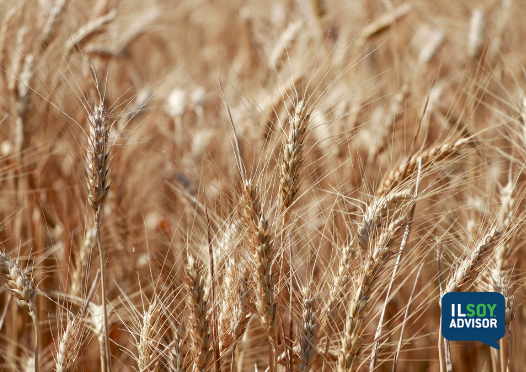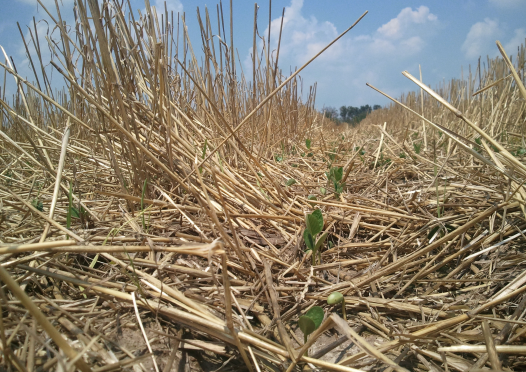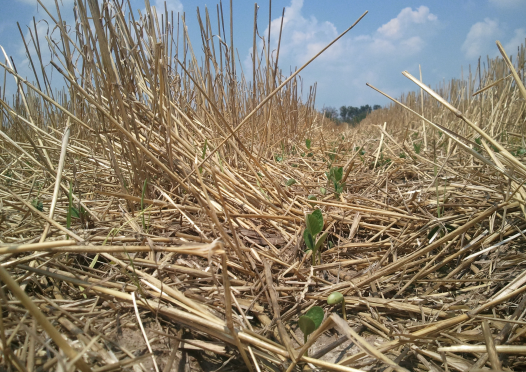BLOOMINGTON, Ill. — The Illinois Wheat Association (IWA) in conjunction with the Illinois Soybean Association is excited to announce the Double Crop Farmers Forum, to be held February 8, 2022, at the DoubleTree by Hilton in Mt. Vernon, Illinois.
Presentations at the conference include best practices for maximizing yields of double-cropped wheat and soybeans, methods to manage diseases, fertilizer price update, USDA programs, market outlooks,... Read More →
ILSOYADVISOR POST
Maturity Group Considerations for Double-Crop Soybeans
November 13, 2018
Double-cropping soybeans after wheat lets a grower harvest three crops in two years. Recently, there has been a lot of interest in planting ultra-early wheats and harvesting at high moisture. This practice can enable growers to plant soybeans 5 to 10 days sooner and gain an addition bushel per acre per day in soybean yield.
However, what is the right soybean maturity group (MG) to plant when double-cropped after wheat, barley or another crop? The general practice and rule of thumb has been to plant the same MG for double-crop soybeans as for full season soybeans. But is that the correct decision?
Double-cropping soybeans after wheat, barley or some other early crops is quite common from Kansas to Maryland and points south. South of Illinois farmers have expressed interest in extending the maturity 0.5 units from the full-season rating. Their reasoning is that if they plant their regular maturity, they find the soybeans maturing too quickly in the fall while there is still season left to fill out the pods, leaving unrealized yield potential on the table.
The Illinois Soybean Association funded a double-crop research project that included varieties of early and conventional maturity wheat and different maturity soybeans at four locations across Illinois. The locations, from south to north, included Marion, Effingham, Wyoming and Walnut. Wheat seed companies recommended appropriate early and conventional maturity varieties for each site. As a team, we decided that for the two southern locations the soybean maturities would be the appropriate full season plus half a unit (+0.5). For the two north locations we decided to use the appropriate full season and reduce half a unit (-0.5)
While the soybean yield results of the trial aren’t completed yet we do know that the first hard frost did take out early the extended maturity in the south and the full season maturity in the north. My preliminary conclusion is that in Southern Illinois, the full season maturity is probably the right maturity. However, in Northern Illinois maybe half a unit reduction wasn’t enough; maybe it should be as short as MG2 or perhaps even less.
What is the right maturity for double-cropping soybeans north of Bloomington, Peoria and Interstate 80? The general rule of thumb for late planted soybeans is to plant full season through May and after June 1, reduce the maturity by half a unit. That was the logic behind why we selected the half unit reduction in maturity. But, since double-cropped soybeans are planted after June 20 and even July 1, maybe that is not short enough—maybe it should be a full unit reduction in maturity.
What is the ‘right’ maturity of soybeans to plant after wheat in the northern half of the state? Emerson Nafziger, professor emeritus at the University of Illinois, said, “Getting a crop planted that late to maturity that far north requires warm weather extending later into October than normal, so variety maturity may not make a whole lot of difference, though we should never plant one that’s past a mid-group 2, which is already pretty typical for full-season planting.”
He explained, “Soybeans planted that late will flower as soon as they reach about V3 and an MG1 variety won’t flower much earlier than MG2, since nights are long enough to trigger flowering of both as soon as the plants are physiologically able to flower. That nights are always warm in July helps them to flower early. We can expect MG2s to flower over a little longer period than MG1s, and that can be an advantage if August and September conditions are good, but a disadvantage if it turns dry or if it cools down early.”
So, how short of a maturity can we plant 100 miles south and north of I-80? I reached out to soybean specialists in nearby states and asked their opinion on appropriate maturity.
- Illinois: Emerson Nafziger, U of I, MG 2 to 2.5
- Wisconsin: Shaun Casteel, U of W, 2.5 to 2.8 (any less reduces yield potential)
- Ohio: Laura Lindsey, OSU 3.0 to 3.5 MG
- Indiana: Shaun Casteel, Purdue University, 3.0 to 3.5 MG
When the results from the double-crop study are analyzed, we will have some preliminary results on the impact of MG on yield. Nevertheless, we want the variety to be as mature as possible before the first hard frost hits, so the right MG selection is important. Guess our half unit reduction in maturity wasn’t too far off the mark.
Soybean agronomist Dr. Daniel Davidson posts blogs on topics related to soybean agronomy. Feel free to contact him at djdavidson@agwrite.com or ring him at 402-649-5919.





Comments
Add new comment